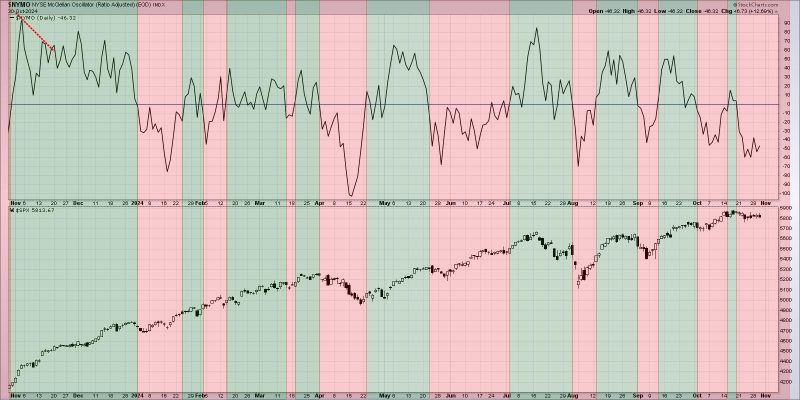November 1, 2024
Breaking Point: Do Breadth Divergences Spell the Bull Market’s Demise?
 Breadth Divergences: A Key Indicator for Assessing Market Trends
Market analysts and investors often look to a variety of technical indicators to gain insight into the direction of the markets. One such indicator that has gained traction in recent years is breadth divergences. Breadth divergences, which measure the number of advancing and declining stocks in an index, can provide valuable signals about the strength and sustainability of a market trend.
When the broader market is rising, investors typically expect to see a high number of stocks participating in the rally. This is known as market breadth, and it is often used as a confirmation of the overall strength of the market trend. Conversely, when market breadth starts to diverge from the direction of the market index, it can signal underlying weakness or inconsistencies that may indicate a potential reversal in the trend.
One common type of breadth divergence is the bearish breadth divergence, which occurs when the market index is making new highs, but the number of advancing stocks is declining. This can suggest that the market rally is being supported by only a handful of stocks, rather than a broad-based participation. In such cases, the risk of a market reversal increases, as the lack of breadth support can make the market vulnerable to a sudden pullback.
On the other hand, bullish breadth divergences can also provide valuable insights into the market dynamics. A bullish breadth divergence happens when the market index is trending lower, but the number of advancing stocks is increasing. This can indicate that there is underlying strength in the market, with more stocks starting to show positive momentum even as the overall market may be struggling. In such cases, investors may view the divergence as a potential signal for a reversal in the market trend and an upcoming rally.
It is important to note that breadth divergences are just one of many technical indicators that investors use to assess market trends. While they can provide valuable signals, they should not be used in isolation to make investment decisions. It is essential to consider a range of factors, including fundamental analysis, market sentiment, and economic indicators, to gain a comprehensive understanding of the market environment.
In conclusion, breadth divergences can offer valuable insights into the strength and sustainability of market trends. By monitoring the number of advancing and declining stocks in conjunction with other technical and fundamental indicators, investors can better assess the underlying dynamics of the market and make informed investment decisions. While breadth divergences can be powerful tools, they should be used in conjunction with other forms of analysis to get a complete picture of the market landscape.
Breadth Divergences: A Key Indicator for Assessing Market Trends
Market analysts and investors often look to a variety of technical indicators to gain insight into the direction of the markets. One such indicator that has gained traction in recent years is breadth divergences. Breadth divergences, which measure the number of advancing and declining stocks in an index, can provide valuable signals about the strength and sustainability of a market trend.
When the broader market is rising, investors typically expect to see a high number of stocks participating in the rally. This is known as market breadth, and it is often used as a confirmation of the overall strength of the market trend. Conversely, when market breadth starts to diverge from the direction of the market index, it can signal underlying weakness or inconsistencies that may indicate a potential reversal in the trend.
One common type of breadth divergence is the bearish breadth divergence, which occurs when the market index is making new highs, but the number of advancing stocks is declining. This can suggest that the market rally is being supported by only a handful of stocks, rather than a broad-based participation. In such cases, the risk of a market reversal increases, as the lack of breadth support can make the market vulnerable to a sudden pullback.
On the other hand, bullish breadth divergences can also provide valuable insights into the market dynamics. A bullish breadth divergence happens when the market index is trending lower, but the number of advancing stocks is increasing. This can indicate that there is underlying strength in the market, with more stocks starting to show positive momentum even as the overall market may be struggling. In such cases, investors may view the divergence as a potential signal for a reversal in the market trend and an upcoming rally.
It is important to note that breadth divergences are just one of many technical indicators that investors use to assess market trends. While they can provide valuable signals, they should not be used in isolation to make investment decisions. It is essential to consider a range of factors, including fundamental analysis, market sentiment, and economic indicators, to gain a comprehensive understanding of the market environment.
In conclusion, breadth divergences can offer valuable insights into the strength and sustainability of market trends. By monitoring the number of advancing and declining stocks in conjunction with other technical and fundamental indicators, investors can better assess the underlying dynamics of the market and make informed investment decisions. While breadth divergences can be powerful tools, they should be used in conjunction with other forms of analysis to get a complete picture of the market landscape.
If you would like to delve into the world of investment topics , go to our partner project Wall Street Wizardry


